The Infantry Officer's Sword
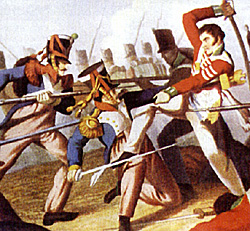 Right up until the middle of the 18th Century, British officers had carried a staff weapon called a spontoon as a mark of their authority and it was only after the experiences of war in North America and India, where the weapons proved to be near useless encumbrances that persuaded the authorities to order the adoption of the sword in 1786.
Right up until the middle of the 18th Century, British officers had carried a staff weapon called a spontoon as a mark of their authority and it was only after the experiences of war in North America and India, where the weapons proved to be near useless encumbrances that persuaded the authorities to order the adoption of the sword in 1786.
The first official regulation sword was introduced in 1796. It had a long straight bladew 32 inches long and 1 inch wide and designed to be suitable for both cut and thrust. It was fitted with a double shell hilt. The 1796 Pattern Sword was the weapon carried bythe majority of the officers during the Napoleonic Wars.
However, the 1796 pattern proved unpopular with the officers of the flank companies (Grenadiers and Light Infantry) who disliked its flimsy blade and fragile guard. They preferred to carry a simple knucklebow or stirrip guard and this paractice became so widespread that it was finally authorized in 1799. Then in 1803, a new sword was approved specifically for Grenadiers and the Light Infantry officers. The 1803 Patter Sword had a curved bladeapproximately 30.5 incheslong and 1.37 inches wide, with a knucklebow guard bearing the royal cipher. Some swords also had a grenade or bugle, denoting light infantry), others not.
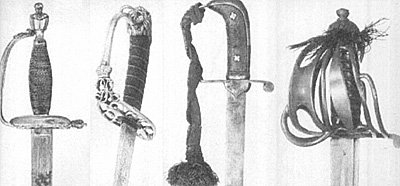 Some regiments however, in particular the Light Infantry regts such as the 43rd and 52nd, still refused to adopt the regulation sword and as a mark of their elite status adopted their own regimental patterns. Officers o fthe Experimental Rifle Corps (later the 95th) were instructed in 1802 to carry a sabre similar to the light cavalry, and there are several surviving examples of the 1796 pattern with shorter blades.
Some regiments however, in particular the Light Infantry regts such as the 43rd and 52nd, still refused to adopt the regulation sword and as a mark of their elite status adopted their own regimental patterns. Officers o fthe Experimental Rifle Corps (later the 95th) were instructed in 1802 to carry a sabre similar to the light cavalry, and there are several surviving examples of the 1796 pattern with shorter blades.
The officers of the Highland Regts carried the traditional basket-hilted sword, although the practice of wearing sabres was common in the flank companies, and some officers seem to have preferred the lighter infantry sword. The 1798 Pattern Broadsword had a double edged blade 32 inches long and 1.25 inches wide.
As an officer in the 74th, SHarpe with his preference for heavier weapons, would probably have used a basket hilted broadsword. When he transferred to the 95th, he carried a regimental pattern sabre until this was broken by Col.de l'Eelin during the retreat to Vigo.
The Cavalry Sword
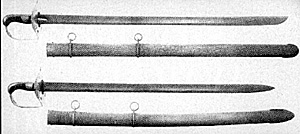 The 1788 Pattern swords used by British cavalry at the outbreak of the wars with France proved so unsatisfactory in the early campaigns in the Low Countries that it was decided to replace them. The Long straight bladed heavy cavalry sword was so heavy and ill-balanced, it was not unknown for the trooper to injure himself or his horse. The light cavalry sword gave poor protection to the hand and was insufficiently curved for effective slashing.
The 1788 Pattern swords used by British cavalry at the outbreak of the wars with France proved so unsatisfactory in the early campaigns in the Low Countries that it was decided to replace them. The Long straight bladed heavy cavalry sword was so heavy and ill-balanced, it was not unknown for the trooper to injure himself or his horse. The light cavalry sword gave poor protection to the hand and was insufficiently curved for effective slashing.
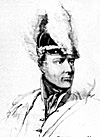 In authorizing new swords, the Board of Ordnance was particularly interested in the observations of Gen. John Gaspard de Marchant (left). Having seen first hand the poor performance in Flanders, he visited many swordsmith in Birmingham and Sheffield with a view towards redesign. He proposed that a light, heavily curved slashing sword be used rather than a straight thrusting sword, and this be adopted by all types of cavalry. He submitted his findings in the form of A Plan for Constructing and Mounting in a Different Manner the Swords of the Cavalry. He further advanced his thesis is his Rules and Regulations for the Sword Exercise of the Cavalry published in 1796.
In authorizing new swords, the Board of Ordnance was particularly interested in the observations of Gen. John Gaspard de Marchant (left). Having seen first hand the poor performance in Flanders, he visited many swordsmith in Birmingham and Sheffield with a view towards redesign. He proposed that a light, heavily curved slashing sword be used rather than a straight thrusting sword, and this be adopted by all types of cavalry. He submitted his findings in the form of A Plan for Constructing and Mounting in a Different Manner the Swords of the Cavalry. He further advanced his thesis is his Rules and Regulations for the Sword Exercise of the Cavalry published in 1796.
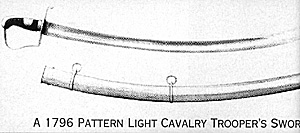 The design for the 1796 Pattern Light Cavalry Sword was almost exactly as Le Marchant specified. It weighted 2 pounds 2 oz. had a curved blade 33 inches long with a hatchet up and 1.5 inch wide, and was fitted with a simple stirrup hilt. The blade of the officer's sword was decorated--sometimes blued and glit, somtimes etched or engraved, and often carried a slightly more ornate hilt. It proved a fearsome weaponand inflicted terrible wounds, so much so that one French commander after witnessing its use in the Peninsula is reported to have wished it banned from the battlefield.
The design for the 1796 Pattern Light Cavalry Sword was almost exactly as Le Marchant specified. It weighted 2 pounds 2 oz. had a curved blade 33 inches long with a hatchet up and 1.5 inch wide, and was fitted with a simple stirrup hilt. The blade of the officer's sword was decorated--sometimes blued and glit, somtimes etched or engraved, and often carried a slightly more ornate hilt. It proved a fearsome weaponand inflicted terrible wounds, so much so that one French commander after witnessing its use in the Peninsula is reported to have wished it banned from the battlefield.
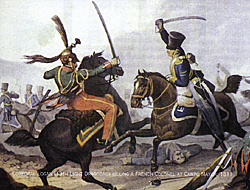 When Sir Wellesley's horse was killed at the battle of Assaye and the general lay helpless, Sharpe saved the future Duke of Wellington with the aid of a 1796 pattern sword, which he had grabbed from the Duke's dead orderly, a tropper in the 19th Dragoons.
When Sir Wellesley's horse was killed at the battle of Assaye and the general lay helpless, Sharpe saved the future Duke of Wellington with the aid of a 1796 pattern sword, which he had grabbed from the Duke's dead orderly, a tropper in the 19th Dragoons.
Le Marchant's ideas were not accepted for the new 1796 Pattern Heavy Cavalry Sword which was instead a copy of the Austrian Model 1775 Pallasche fur Kurassier, Dragoner, and Cheavulegers. The sword weighed 2 pounds 6 oz., had a long straight blade 35 of inches and 1.5 inches wide, and was fitted with a disc hilt. Officers blades were decorated and the guard was a new design called a ladder pattern.
Adj. Gen. Office 1796Rules and Regulations for the Sword Exercise of the Cavalry, London With thanks to Bernard Cornwall, Sean Bean, Amanda Douglas McCaig, and Carlton Television.
More Sharpe
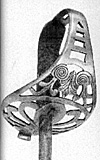 When Sharpe's sabre was broken, he was given a 1796 Pattern Heavy Cavalry sword by the dying Capt. Murray. He carried it until 1812, when it snapped in combat with Col. Leroux and was replaced with one found in the armoury of Salamanca and repaired by Sgt. Harper.
When Sharpe's sabre was broken, he was given a 1796 Pattern Heavy Cavalry sword by the dying Capt. Murray. He carried it until 1812, when it snapped in combat with Col. Leroux and was replaced with one found in the armoury of Salamanca and repaired by Sgt. Harper.
Further Reading
Bailey, DW. 1986 British Military Longarms 1715-1865 (Rev. Ed.) London
Bailey, DW 1990. From India to Waterloo: The India Pattern Musket. In London National Army Museum. The Road to Waterloo: The British Army and the Struggle Against Revolutionary and Napoleonic France 1793-1815.
Blackmore, HL 1994. British Military Firearms 1650-1850. London.
Baker, E. 1823. Remarks on Rifle Guns, Being the Result of 40 Years Practice and Observations. London.
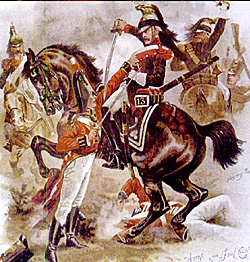 Rimer, G. The Weapons of Wellington's Army. In Griffith, P. (ed.).Wellington Commander: The Iron Duke's Generalship. Chichester.
Rimer, G. The Weapons of Wellington's Army. In Griffith, P. (ed.).Wellington Commander: The Iron Duke's Generalship. Chichester.
Robson, B. 1996. Swords of the British Army: The Regulation Patterns 1788-1914. London.
Robson, B. 1990. Warranted Never to Fail: The Cavalry Sword Patterns of 1796. In London, National Army Museum. The Road to Waterloo: The British Army and the Struggle Against Revolutionary and Napoleonic France 1793-1815.
Acknowledgements
Sharpe's Weapons: Introduction
Sharpe's Weapons: Richard Sharpe
Sharpe's Weapons: Firearms
Sharpe's Weapons: Swords
Back to Age of Napoleon No. 28 Table of Contents
Back to Age of Napoleon List of Issues
Back to MagWeb Master List of Magazines
© Copyright 1998 by Partizan Press.
This article appears in MagWeb (Magazine Web) on the Internet World Wide Web.
Other military history articles and gaming articles are available at http://www.magweb.com